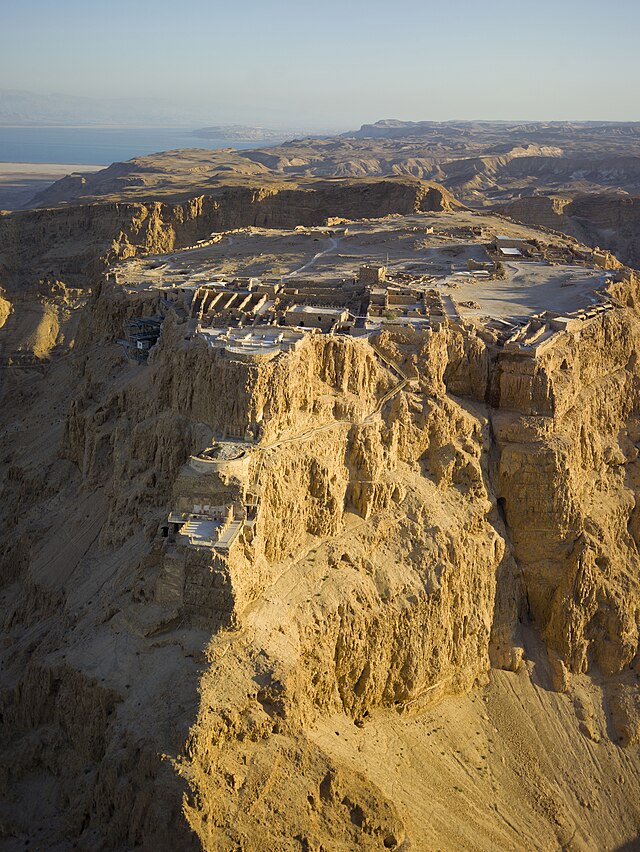This is a video well worth your time watching, not to scare you but to realize that God is in control and all these things have to come to pass.
New Warning Signs: SHOCKING PROPHETIC EVENTS TO COME IN 2015
https://www.youtube.com/watch?v=dl3SAiXUQpw



Yesterday, I watched the conclusion of a two part movie called "The Dovekeepers". The film uses much artistic licence however, it brings light to this event in our history. It is a story about the Jewish people who took their own lives in Masada. In the movie,over nine hundred people were commissioned to 10 men, to kill themselves before the Roman soldiers would overtake their fort. I was thinking, what tremendous bravery it took, for them to die rather than fall into the hands of the Romans. They knew from their youth that suicide was not what they would consider, ever, and was not what God wanted, but under the circumstances this is what occurred.
Wikipedia- Masada
Masada (Modern Hebrew מצדה metzadá "fortress"[1]) is an ancient fortification in the Southern District of Israel situated on top of an isolated rock plateau akin to a mesa on the eastern edge of the Judaean Desert, overlooking the Dead Sea. Herod the Great built palaces for himself on the mountain and fortified Masada between 37 and 31 BCE. According to Josephus, the Siege of Masada by troops of the Roman Empire towards the end of the First Jewish–Roman War ended in the mass suicide of the 960 Sicarii rebels and their families hiding there. Masada is located 20 kilometres (12 mi) east of Arad.
Masada is one of Israel's most popular tourist attractions.[2]
Geography
The cliffs on the east edge of Masada are about 400 m (1,300 ft) high and the cliffs on the west are about 90 m (300 ft) high; the natural approaches to the cliff top are very difficult. The top of the plateau is flat and rhomboid-shaped, about 550 m (1,800 ft) by 270 m (890 ft). There was a casemate wall around the top of the plateau totaling 1,300 m (4,300 ft) long and 4 m (13 ft) high, with many towers, and the fortress included storehouses, barracks, an armory, the palace, and cisterns that were refilled by rainwater. Three narrow, winding paths led from below up to fortified gates.History
Main article: Siege of Masada
Almost all historical information about Masada comes from the 1st-century Jewish Roman historian Josephus. The site was first fortified by Alexander Jannaeus in the first century BCE.[3] Herod the Great captured it in the power-struggle that followed the death of his father Antipater.[3] It survived the siege of the last Hasmonean king Antigonus II Mattathias, who ruled with Parthian support.[3] In 66 CE, a group of Jewish rebels, the Sicarii, overcame the Roman garrison of Masada with the aid of a ruse.[3] After the destruction of the Second Temple in 70 CE, additional members of the Sicarii fled Jerusalem and settled on the mountaintop after slaughtering the Roman garrison.[3]
According to Josephus, the Sicarii were an extremist Jewish splinter
group antagonistic to a larger grouping of Jews referred to as the
Zealots, who carried the main burden of the rebellion. Josephus said
that the Sicarii raided nearby Jewish villages including Ein Gedi, where they massacred 700 women and children.[3][4][5][6]In 73 CE, the Roman governor of Iudaea Lucius Flavius Silva headed the Roman legion X Fretensis and laid siege to Masada.[3] The Roman legion surrounded Masada, and built a circumvallation wall and then a siege ramp against the western face of the plateau.[3]
According to Dan Gill,[7] geological investigations in the early 1990s confirmed earlier observations that the 375-foot (114 m) high assault ramp consisted mostly of a natural spur of bedrock. The ramp was complete in the spring of 73, after probably two to three months of siege, allowing the Romans to finally breach the wall of the fortress with a battering ram on April 16.[8] Romans took the X Legion and a number of auxiliary units and Jewish prisoners of war, totaling some 15,000 troops in order to crush Jewish resistance at Masada. A giant siege tower with a battering ram was constructed and moved laboriously up the completed ramp. Originally, Jewish rebels on top of Masada threw stones at those building and constructing the ramp. When this plan was realized, the Romans put captured Jewish prisoners from previously conquered towns to work the ramp. The Jewish people on top of Masada stopped killing those who built the ramp, choosing not to kill their fellow Jews, even though they understood this might result in the Romans penetrating the fortress.[citation needed] The walls of the fortress were breached in 73 CE.[9] According to Josephus, when Roman troops entered the fortress, they discovered that its 960 inhabitants had set all the buildings but the food storerooms ablaze and committed mass suicide or killed each other. Josephus wrote of two stirring speeches that the Sicari leader had made to convince his fellows to kill themselves.[3] Only two women and five children were found alive.[3] Josephus presumably based his narration upon the field commentaries of the Roman commanders that were accessible to him.[10][11] There are significant discrepancies between archaeological findings, and Josephus' writings. Josephus mentions only one of the two palaces that have been excavated, refers only to one fire, while many buildings show fire damage, and claims that 960 people were killed, while the remains of only 28 bodies have been found.[12]
The year of the siege of Masada may have been 73 or 74 CE.[13]
Masada was last occupied during the Byzantine (Eastern Roman Empire) period of rule, when a small church was established at the site.[14]
No comments:
Post a Comment